
Blog written by Jiaze Li and Minxue Tang (LEMONTREE ERCs)
October in Colombia marks the transition from summer to the rainy season and this year, it also marked the long anticipated COP16. From the 20th October to the 1st November, scientists and experts from around the world gathered in Cali, Columbia for the 16th Conference of the Parties to the Convention on Biological Diversity. This is the first COP since adopting the Kunming-Montreal Global Biodiversity Framework (GBF) in 2022. The conference reviewed the GBF’s progress, identified challenges, and proposed forward-looking solutions to craft a clearer and more actionable blueprint for achieving biodiversity goals.
Minxue Tang and I (Jiaze Li) attended COP16 as Academic & Research delegates from Imperial College London. This was my first time participating in a COP, where we engaged with experts across disciplines to explore how our research could provide scientific support for achieving the GBF targets. For Minxue, this is her second UN conference journey, and with her experience, I received invaluable support and suggestions throughout the conference.
Our side event – “How does plant diversity respond to climate change?”
The COP16 venue is spread across two main zones – Blue and Green. The Blue Zone serves as the formal conference and negotiation space, open only to Party delegations, admitted observers and the accredited press, while the Green Zone is open to the public and showcases a dynamic blend of performances, exhibitions, and interactive activities.
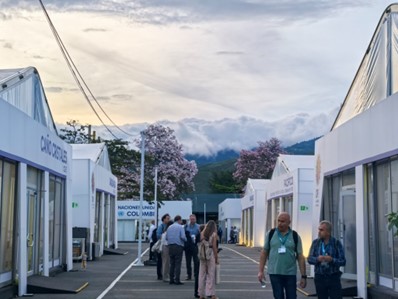
In the Blue Zone, Minxue and I organised a side event titled “How Does Plant Diversity Respond to Climate Change?” This side event brought together experts from academia, government, NGOs and industry to explore the complex feedback loops between plant biodiversity and climate change. The discussions ranged from theoretical frameworks to practical solutions: how climate change impacts the distribution and migration of plant diversity, the interplay between plant biodiversity loss and carbon sequestration, the role of AI in biodiversity research, ecological agriculture in the Amazon, and Colombia’s efforts in conservation and ecological restoration. Through these discussions, we facilitated cross-disciplinary collaboration and developed practical ideas for addressing the interlinked challenges of biodiversity loss and climate change.
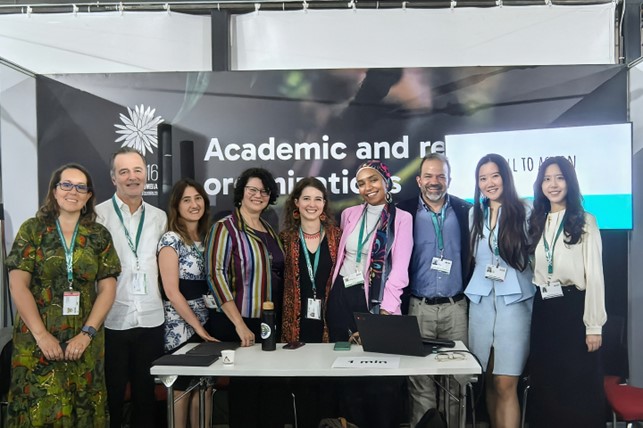
Group photo of our side event: “How Does Plant Diversity Respond to Climate Change?”


Left: Jiaze Li sharing her ideas and research (photo credit, Philipp Montenegro); Right: Minxue chairing the side event and discussing her research.
LEMONTREE research and COP16 outcomes
As researchers from the LEMONTREE group, Minxue and I grabbed another opportunity to present our research projects at an official academic event, “Academia and Research Actions for the CBD Global Biodiversity Framework”, organised by the Academia and Research Caucus.
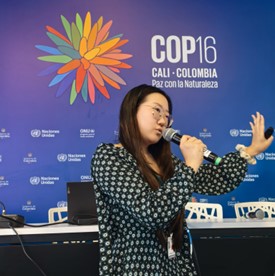
Minxue Tang presented her research on how, when and why European tree distributions have shifted during the past 12000 years. Utilising comprehensive fossil pollen records alongside advanced mathematical modelling techniques, she reconstructed historical climate change and plant migration patterns. Her findings explore the intricate relationship between tree history and climate dynamics, showcasing valuable insights into how past ecological shifts can inform our understanding and approaches to future climate scenarios.

I shared my research on the spatial and temporal impacts of climate change on global patterns of vascular plant diversity through the lens of climate analogues. My findings help explain why the tropics have more species: analogues of recent tropical climates emerged earlier and are more prevalent across space and time. These findings emphasise the need to integrate both temporal and spatial scales when studying the climate change impacts on biodiversity and inspire the potential application of ‘climate analogues’ to identify regions at risk and potential biodiversity refuges under ongoing climate change.
One of the core themes of COP16 is the “synergies between biodiversity and climate change” with biodiversity loss and climate change framed as “inseparable challenges.” Parties reached a consensus to address biodiversity loss and climate change together. The COP16 also highlighted the critical role of plant diversity, prompting actions that include developing “integrated management plans” for key plant diversity areas and enhanced monitoring and conservation efforts. The goals of the LEMONTREE group align closely with these initiatives –and our research is contributing to both policy development and practical efforts to achieve these shared global targets.
By the closing day of COP16, only 44 out of 196 Parties (22%) had submitted their National Biodiversity Strategies and Action Plans (NBSAPs), falling short of their pre-conference commitments. This gap reflects the deep-rooted complexities of aligning political will with tangible action on the ground. Yet, this also marks the start of renewed efforts to turn ambitions into outcomes for biodiversity and climate resilience. The road ahead may not always align perfectly with our expectations, but in the process, we discover new perspectives and opportunities for meaningful change.
“As a woman, a scientist, and an Asian, these identities come with additional challenges. On international platforms like the United Nations, Asian representation is still scarce. In this year’s delegation of researchers I am part of, there are only two of us from China. Similarly, in the fields of Science, Technology, Engineering, and Mathematics (STEM), even in Western countries, the number of women scientists remains relatively small. This issue also extends to recognising women’s contributions to global efforts, such as environmental conservation. At COP16, one of the main topics was acknowledging the enormous efforts women, especially Indigenous women in less developed regions like Colombia, make to conserve nature. Many of these women work voluntarily, driven by habit or tradition, to protect the environment. For example one of the side sessions running in the blue zone this year was “Indicator methodology to measure national implementation of the Gender Plan of Action.” Compared to my experience at the UNFCCC Climate Change Conference 2019 in Bonn, Germany, where such topics were notably absent, it is encouraging to see these discussions finally gaining attention at COP16.” – Minxue Tang
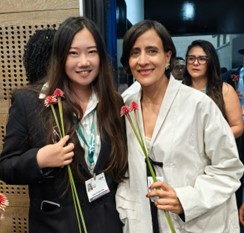
Minxue Tang with COP16 President Susana Muhamad, who said “We need more Women in Science like you”. At COP16, one of the main topics was acknowledging the enormous efforts women, especially Indigenous women in less developed regions like Colombia, make to conserve nature. Great to see this promoted on the international stage.
On our final day in Colombia, Minxue and I hiked through the peak Pico de Loro, in the western Andes. Standing in one of the world’s richest hotspots for vascular plant diversity, I was thrilled to see what I had found in my research project in real life. Alexander von Humboldt’s cross-sectional graphical portrait of the Andes, which I had seen in literature, unfolded before me – a vivid illustration of biodiversity distribution that left me deeply moved – such excitement and shock are beyond words. Every plant here showcases remarkable adaptations to thrive in the unique environment. Towering tropical trees anchor themselves firmly in the shallow soil with sprawling buttress roots to prevent them from falling in storms. “Smart” epiphytic orchids grow on branches of trees, which allow them to acquire sunshine without consuming energy to grow tall. With abundant rainfall, these epiphytic orchids draw all the moisture they need from the air, thriving without ever touching the ground. These intricate systems create a harmonious balance, sustaining the most diverse ecosystem on Earth.
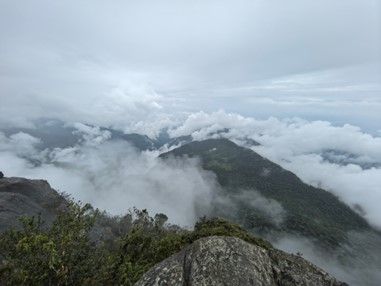
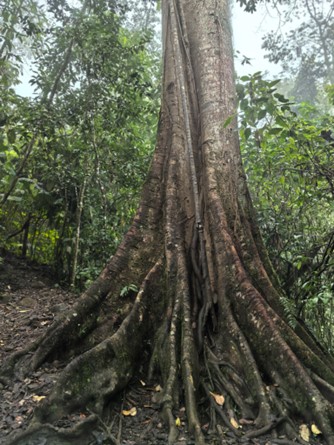
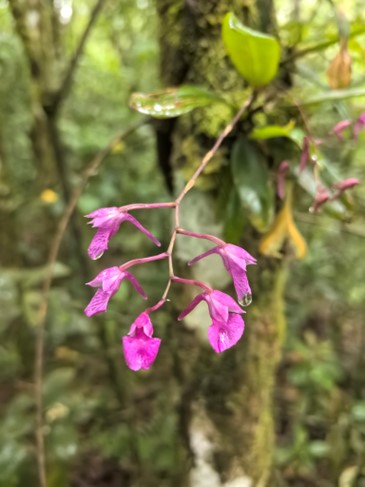
From left to right: The peak Pico de Loro in the Farallones de Cali, buttress roots, and an epiphytic orchid seen on the hike.
Written by Jiaze Li and Minxue Tang
Edited by Minxue Tang and Natalie Sanders
